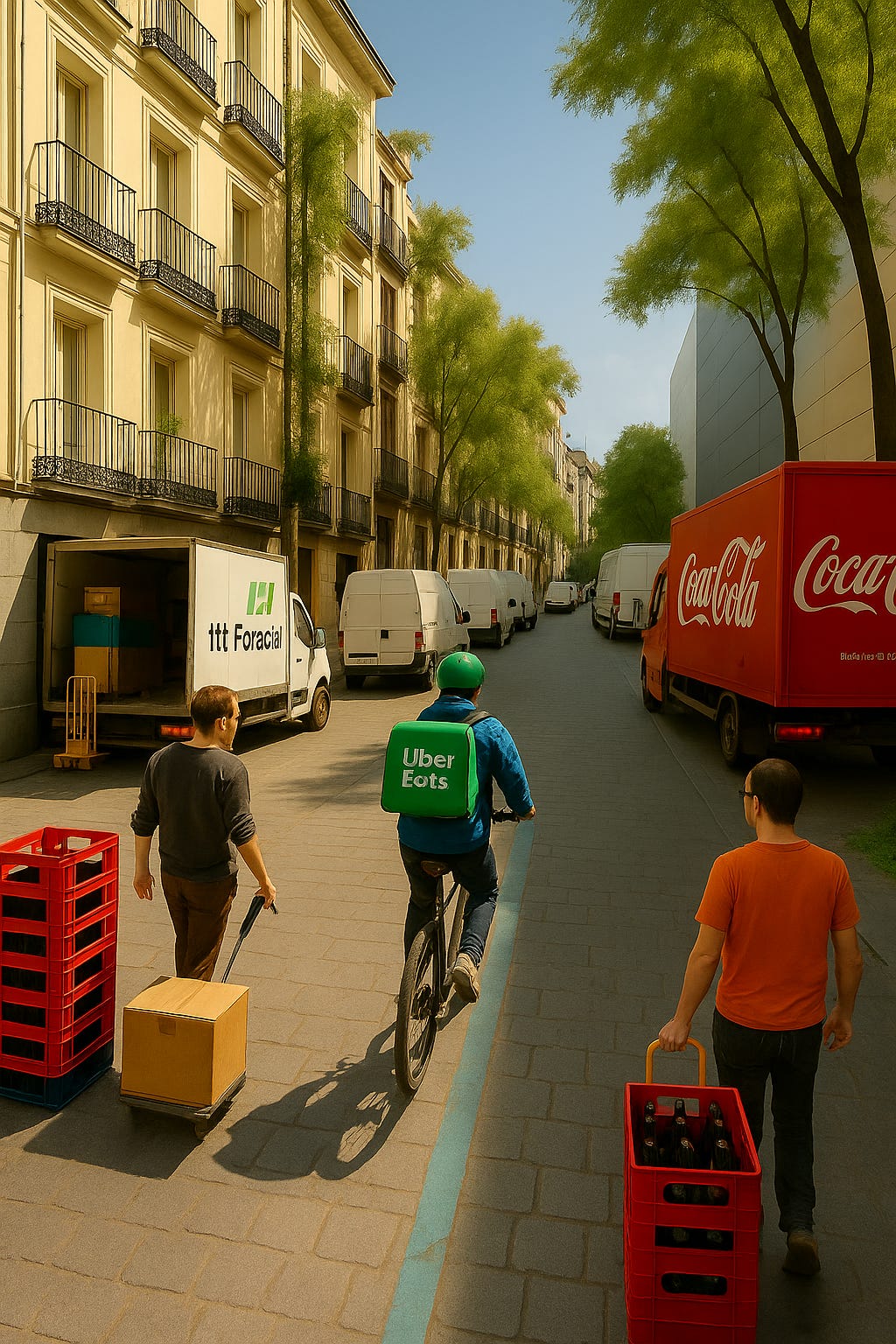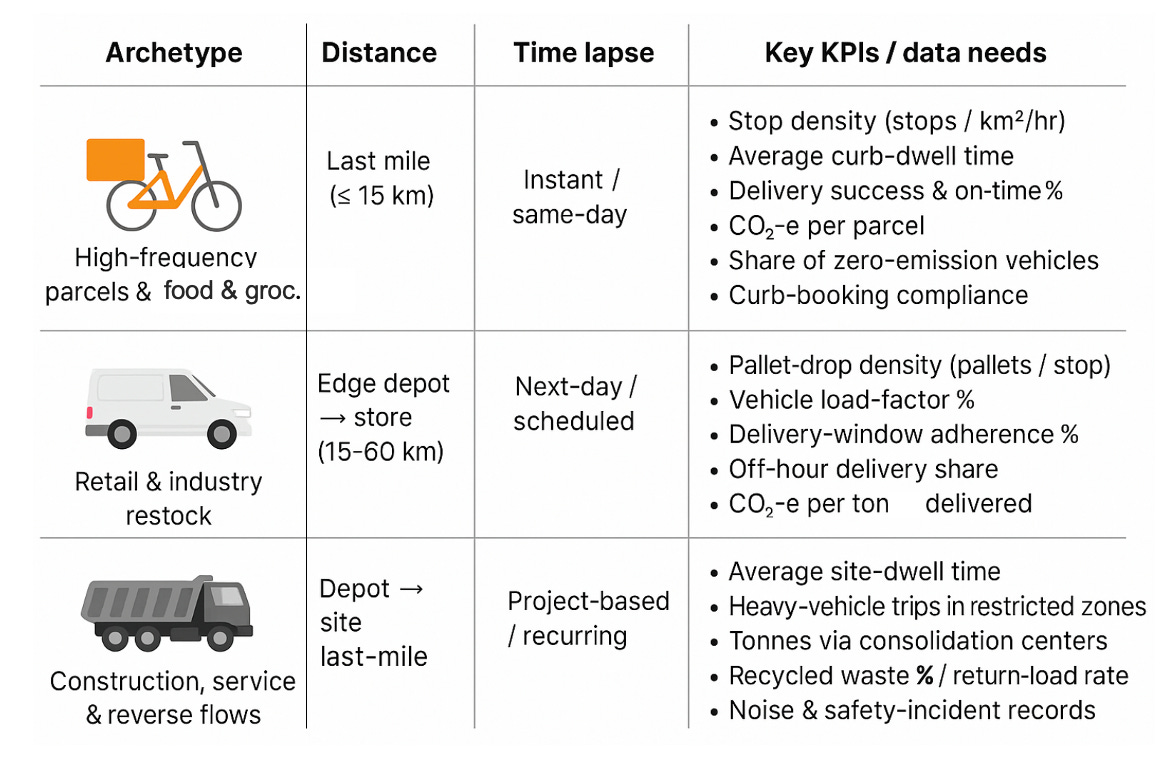15-minute cities won’t work if we don’t get delivery right
Access to accurate data is essential, but that data is mostly missing
As a resident of Madrid, I am lucky enough to live and breathe the 15-minute city: I can walk to work, kids’ school, key errands, the Retiro park and my primary doctor. I love it, but because I’m always in the neighborhood, I know what happens at 11am every weekday: polluting vans clogging streets, cargo bikes running on sidewalks, and delivery workers blocking narrow streets with carts filled up with packages. One delivery worker literally ran over me on the sidewalk of Barquillo street the other day.
The 15-minute city’s appeal can vanish under a pile of parcels.
Urban logistics bring the goods and services that we consume inside cities and take out the waste that we produce as a result. Is the system that runs cities’ metabolism. Unless we fix the flow of goods, the dream of a dense, walkable, and livable city will be darkened by nasty air and loading trucks.
The EU is aware of this, and has begun to treat urban logistics with the relevance it merits. Last December, the Expert Group on Urban Mobility delivered a set of recommendations to improve urban logistics. The recommendations made one point very clear: fixing urban logistics rests on data that cities don’t yet have, and barely know how to use.
What Brussels just delivered… and what’s still missing
First, the stats. In the EU, urban freight…
→ accounts for 15 % of city greenhouse gas emissions and 30 % of local pollutants
→ contributes up to 20 % of the vehicle kilometers travelled
→ employs up to five percent of urban workers.
And these shares are only increasing with e-commerce and the widespread adoption of apps that are transforming how we all consume in cities.
The Expert Group defines Sustainable Urban Logistics Plans (SULPs) as…
“... strategic frameworks designed to optimise the transportation of goods within urban areas, aiming to reduce environmental impact, improve efficiency, and enhance quality of life.”
One thing that struck me out of the gate when reading the document was the Expert Group’s very first recommendation: “Develop an EU-wide common approach for data collection and voluntary data sharing for SULPs, as local authorities are lacking of quality data about urban freight transport flows”.1
To be fair, some cities have started to make progress on this front. The apps for reserving loading and unloading zones developed by Madrid and Barcelona are a good example. Using this data, 300,000km/s, a cool urban analytics company, analyzed last mile delivery in Barcelona.
The Expert Group’s document does mention the app developed by Barcelona. Yet, the data vacuum in most cities, including big and capable ones, is still huge. So while the document’s attention deserves credit, a closer read of the fine print reveals key limitations that also need to be called out:
Not everything is equal in Urban Logistics, and some key sectors aren’t covered
Urban freight comprises different types of goods and services, use of transport modes and infrastructure, and spatial and functional structures. The Expert Group explicitly embraces this diversity, but when it comes to developing recommendations, it does not fully incorporate it. The information generated by a delivery platform is vastly different - in type and accessibility - from data coming out of floating vehicles or that collected from a municipal application to reserve loading and off-loading curb space. I can understand why the document stays at such a high level, but without going deeper into what, for whom, or when, its recommendations lack punch.
The document also misses some key segments in urban logistics. Perhaps the most evident absence are restaurant deliveries and rapid groceries. This sector has been estimated at a global market size of $520.3 billion, with an average growth rate in 2024 of over 10%, and high diversity among analyzed platforms.
Yes, we need data, but to measure what exactly?
While the document is right on target when it calls for the need of data, it falls short in identifying what are the key indicators that cities need to collect to make better decisions. Knowing what the data is for is more important to having tons of data. The opposite is a recipe for an indigestible data deluge. Here, the EU could replicate its work on indicators for sustainable urban mobility plans. This time for urban logistics.
Some good candidates for such indicators are: vehicle kilometers travelled per type of vehicle, CO2 emissions per vehicle type, fleet sizes, curb space use and dwell time, good types delivered by each vehicle type, or delivery success rates.
Governing urban logistics requires data governance
Knowing what information cities need, and for what purposes, is a first key step… of a long journey. City governments will also need to figure out important data governance aspects. A big one are data access terms. Some data may be requested by force, as a condition for using priority loading zones or to get an operating license to run services or deploy a logistics hub. In other cases, data sharing will depend on voluntary arrangements. In both situations, approaches built on dialogue and mutual exchange often prove more fruitful. Cities and companies should also collaborate in setting data standards - see for example the curb data specifications developed within the Open Mobility Foundation - and to ensure compliance with privacy regulations and trade secret protections.
There are also important data plumbing aspects that need to be considered, and that the current document overlooks. For example, will city governments gather real-time data logs and feeds? Real-time often demands costly compute and processing as well as anonymization tools, so this may be too burdensome for many local governments. A clear opportunity for data intermediaries to collect the data and provide the needed insights based on crucial performance indicators.
Mapping data needs to urban logistics archetypes
The best way to start collecting useful and actionable data is to focus on the aspects that matter most for each specific segment in urban logistics. Below is my first attempt at mapping that, but I would love to hear others chime in, ruthlessly criticize, and complement, constructively.
Urban logistics is the 15-minute city’s operating system, and like any OS, its performance depends on the quality of its data layer. The good news is that a lot of the technology stack exists, the standards are maturing, and the business models are quickly evolving.
The onus now is on city governments and their partners. They need to invest in core capacities and share data in a way that preserves trust and delivers actionable information to make good decisions.
If we get that right, the next parcel or meal will glide through the city as quietly and cleanly as a bike ride. If we don’t, the 15-minute city dream will likely stay stuck in traffic.
Beyond data, the document issues more recommendations such as the need to incorporate technological innovations, depot-energy planning, city-staff training and collaborative micro-hubs, among others.





